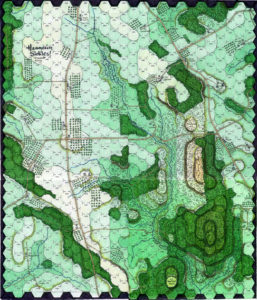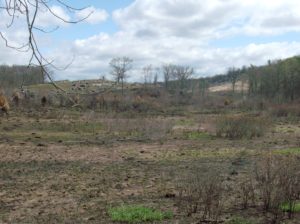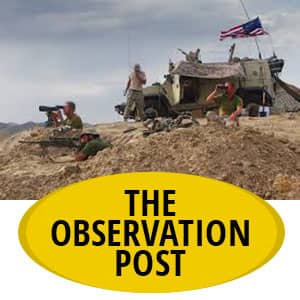By Rick Barber:
Claude Whelan, Dave Powell and I had a great weekend down at ‘Da Burg’, in April 2018, with the weather co-operating at just the right times! We spent Saturday morning walking the center and right of Sickles’ line, and then walking a lot of Sickles’ Ordered position. Dropped the car at the Trostle farm (long ‘O’, to do a correct pronunciation, BTW!), and walked the whole way up to McGilvery’s Arty line, then came back through the woods on the original Trostle lane. Then off to Culp’s Hill to round out that day (as the rain started coming back in.) Thunderstorms and rain the rest of the evening, and Dave Powell had to leave for a dinner engagement with Eric Wittenberg down in Frederick.
Sunday morning Claude and I spent a few hours concentrating on the area of Hood’s Attack, and checking out the results of the enlarged ground burning project started in 2017 – that was a test, but it worked so well that they’re going to keep up with it every year! At a rough count, on our map, there were a full fifteen hexes of ground cover burnt off over the month prior to our visit, fully exposing all the rocks and such you don’t always see. Claude and I agreed that the prospective ‘Players’ Guide’, which hopefully we can produce as a downloadable pdf, can include an enlarged map section of this area, keyed to a series of pictures we took, to help visually ‘explain’ why such terrain I’ve shown as ‘rocky’ is exactly that. Claude had brought along 11 x 17 printouts of the entire Longstreet Attacks map (which were great, considering the wind!), and he marked down where we were taking pictures. I have to take my copy and show where we all hoofed it, but we did about as intensive a ‘ground survey’ as you could.
Those little in-hex streams turn into whole hexes of muck after a good night of rain, and we both came home with both mud and burn marks on our pants, from all the charcoaled brush. We slogged our way through the entire area (enduring balky cameras and lowering batteries), but the view of the Triangular Field from the Weikert/Timbers farm is impressive. Those poor Rebs – once they came down from Warfield Ridge, every bit of high ground they got over was just followed by a higher and nastier one, culminating in cresting Houck’s Ridge to see the monster of Little Round Top across the Valley of Death. Definite negative hit on the morale there, and glad that such was someone else’s job!
I then took Claude on a tour of the two summits of Black Cat Knob, and then on to the ‘D-shaped field’ going up the Big Round Top Park road. We walked down from there to the Slyder farm, giving us another view of the incredible burnings and a different angle on what we had walked earlier. As with the day before, the sun was out for exactly the hours we needed it, and once we got them downloaded and gone through, the pictures were amazing.
First two pictures are from about hex 2421, showing the foreshortened view. you’re looking at Houcks’ Ridge, with Little Round Top behind it.
Next, the lower end of Devil’s Den (hex 2620), followed by Plum Rum from close by, and Rose’s Run, winding its marshy way through the same area.
And finally, views from the Slyder farm (2522) across a flood plain that neither of us wanted to venture into that day. And a view up Slyder’s lane towards the D-shaped field.

This is the very first ‘rough’ map that I did, superimposed over the actual Bachelder/Warren Commission map covering the same area. (Click to Enlarge.)

This is the “original” Hammerin’ Sickles map, before the game, and the map was transferred to “Revolution Games” and became “Longstreet Attacks: The Second Day at Gettysburg.” (Click to Enlarge.)
This map is the ‘first’ version of the actual ‘Hammerin Sickles!‘ map, from back when Herm and I were going to do it as a 17″ x 22″ game. When it caught the attention of Andy Lewis at GMT, who liked the idea so much that he allowed us to expand it into a full 22″ x 34″ map, giving us the chance to show a lot more room to the south in case Longstreet allows Hood to get frisky. So, when Herm brought the game to Revolution, which was the best possible result, the game ended up in the hands of what is, IMO, the best development/playtesting team in the whole industry, and allowed Revolution to keep its hands on the entire ACW Blind Swords series.
When Dave Powell and I walked Sickles’ entire line with my Hammerin Sickles map, he thought I got things pretty well ‘right’ for the scale. I’ll take his word for it. Gettysburg has been a special case for me, as I’ve mapped it in six or more different scales, and for many years had absolute access to walking the ground whenever needed. I wish I had that ability for Waterloo and such, but I use Gettysburg as my ‘topographic calibration tool’ for all those fields I map that I’ll never see in person.
Game Resources:
 Longstreet Attacks: The Second Day at Gettysburg BGG Page
Longstreet Attacks: The Second Day at Gettysburg BGG Page
Longstreet Attacks: The Second Day at Gettysburg Home Page


































No walk through Trostle’s Thicket? 🙂
I still have pictures from that day’s adventure Rick. Great article!
Fascinating stuff Rick- please come over to Europe and do Waterloo, most of the battlefield is accessible
Paul H
I’ll pass the word on to Rick. Thanks for commenting. – Fred
As do I, Scott! We were exploring all the results of the new controlled burning’ that they started doing a year or so back, which does a far better and less expensive (in both money and manpower) job than the old brush-clearing methods. A mucky mess last year, though, and so no trip through the Thicket.
Again the same weekend as the Greyhound crowd, so early morning was just watching folks walking what looked like an infestation of small deer. We’re not going down until June this year, though, so will miss that crowd. 😉
I’d love to, Paul, but that’s a bit more of a ‘commute’ than a 45 minute trip down to ‘Da Burg’. I did map all the Waterloo fields at 100/hex for Grognard Sims, but had to rely on ‘secondhand knowledge’, including lots of photos taken and shared by friends who could actually go there. Google Earth is my best friend, especially places like Waterloo where the let you go down to street level and actually ‘drive’ all the roads.